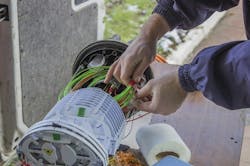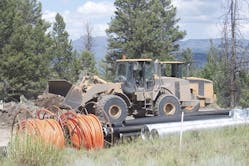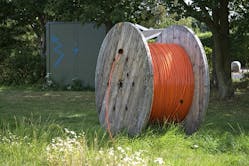Whether they're pursuing fiber to the home (FTTH) and business deployments or pushing fiber deeper into their networks to support DOCSIS 3.1, cable operators have seen fiber compose a greater proportion of their infrastructures. Therefore, they have increased their desire for new methods of speeding deployment, lowering cost, and ensuring success as well. Cable suppliers, connectivity providers, and test instrument houses have responded in hopes that operators will continue to deploy their products in a wider variety of applications.
Innovations in Fiber and Cable
Several recent advances in optical fiber have matured to the point of ubiquity. For example, bend insensitivity is now a standard feature on both drop and in-building cables (not to mention cables for inside the headend and data center). Cable providers have leveraged the bend-insensitive properties to launch a wide variety of cabling options for multiple dwelling units (MDUs). Almost all of the major suppliers now offer portfolios designed to enable easy and unobtrusive deployment along MDU corridors, as well as low-profile access to individual dwelling units. Once inside the customer's apartment, operators also have their choice of approaches to run bare fiber along corners and molding to create connections to the optical network terminal (ONT) that are nearly invisible at first glance.
At the recent 2017 Fiber Connect event in Orlando, FL, produced by the Fiber Broadband Association (formerly known at the FTTH Council Americas), cable suppliers took this concept to the next step with unobtrusive means to get fiber into the premises. Here again, technicians can run thin fiber cables behind storm pipes or beneath trellises to enter low-rise and garden-style apartments unobtrusively from the outside. Multiple suppliers now offer a new generation of indoor/outdoor cable to obviate the need for splices once inside the building to complement such low-profile building entry.
Once they install a fiber broadband network, operators understandably look to leverage the infrastructure for as many purposes as possible. This could include meeting the needs of business customers or using the network for mobile backhaul and, as centralized radio access network (C-RAN) architectures take hold for 4G LTE and upcoming 5G mobile networks, fronthaul applications as well. To make multi-use networks more feasible, connectivity vendors used Fiber Connect to display new and existing portfolios of single-fiber and multi-fiber service access points and local convergence cabinets that offer the flexibility to support different drop and pass-through configurations.
to increase deployment efficiency.
In many instances, these access points and cabinets come preterminated or otherwise factory-configured. Cabling manufacturers generally have promoted the use of preterminated connections over the field-spliced alternative, suggesting that they're less complex, save time, and offer better connection performance. Nevertheless, sources at such vendors admit that while preconnectorization is gaining ground, it is doing so slowly. Splice-on connectors offer more flexibility and reduce the chance of having unnecessary slack cable. And connector manufacturers continue to make strides in reducing connectorization time and improving the odds of a clean, successful process the first time.
Splicer vendors, of course, are more than willing to aid in the achievement of this goal. Along these lines, splice equipment has advanced in the accuracy with which they can align single-mode fiber cores to ensure the best slice possible. However, a source at one vendor at Fiber Connect (who asked for anonymity for himself and his company), suggested that splicing and fiber technology have advanced far enough to enable cladding-based alignment for splicing. A product that leverages cladding-based alignment could be coming in the next several months, the source suggested.
Install It Right
But advances in technology don't help if technicians don't install the fiber cable properly. For example, Kevin Kress, an application engineer at Clearfield, urged attendees of this month's edition of the SCTE∙ISBE LiveLearning Webinars for Professionals Series™ to weigh carefully any inclination they may have to avoid ducting when running fiber to the customer premises. Kress, who won the Fiber Broadband Association's Photon Award for his work within the organization and the industry at Fiber Connect, said that while there are several variables that network installation planners must weigh in determining the business case for ducting, a little investment up front can save a lot of problems in the future – and help ensure happy customers. He offered a link to an independent study of the issue for those seeking additional information.
Similarly, testing, certifying, and troubleshooting network installations aren't areas where technicians should cut corners either. Jim Hayes, president of The Fiber Optic Association, reminded attendees of the SCTE∙ISBE webinar that dirty connectors remain the number one cause of faulty connections. Proper installation practices, including inspection, often can avoid such problems, he pointed out. Hayes offered a list of necessary test steps for a successful installation, as well as made the provocative statement that, left undisturbed, fiber networks don't need maintenance and therefore, once installed, shouldn't be touched by anyone other than trained, certified personnel.
However, as optical networks and the transmission technologies employed over them become more complex, tests have become more complex as well. Test instrument providers have responded by making pass/fail determinations more automatic. While Hayes looked somewhat askance at one-button pass/fail tests, their advent has made verification of proper installation easier to perform, particularly for technicians used to working with coax and other non-fiber media.
Meanwhile, new test challenges are on the horizon, particularly as next-generation PON-based systems reach the field. 10G-EPON has been available for some time, which means that PON testers must be capable of detecting and measuring the approach's new wavelengths. Such problems become more acute in the GPON realm, where symmetrical XGS-PON and multiwavelength NG-PON2 promise not only symmetrical 10 Gbps but a host of new wavelengths that test equipment must take in to account.
Meanwhile, CableLabs has begun to examine the use of coherent transmission technology for fiber distribution networks. A test methodology for such transmission awaits a determination of how coherent would be deployed and how detailed a look at the transmission stream initial certification and eventual troubleshooting would require.
With these thoughts in mind, operators and installers could be forgiven if they concluded that for every effort to make fiber installation easier, a new complexity arises. However, technologists have made significant strides in lowering the cost and easing the burden of fiber network installation. Despite the promise of DOCSIS 3.1, cable MSO strategists continue to say that the future of their networks is fiber. Regardless of when that future arrives – and for operators such as Altice USA, that future is at hand – operators would do well to be sure they're ready.
Stephen Hardy is editorial director of Broadband Technology Report.
Learn Best Practices for Fiber Construction and Restoration
You can now view on-demand the June 2017 SCTE∙ISBE LiveLearning Webinars™ for Professionals webcast, produced by BTR, “Fiber Construction and Restoration.” This webcast highlights ways to get the most for your fiber investment and plan for future service capabilities. Register for the webinar and view it now!







